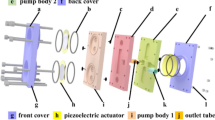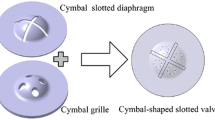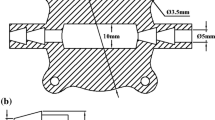Abstract
Due to the limited output capability of piezoelectric diaphragm pumps, the driving voltage is frequently increased to obtain the desired output. However, the excessive voltage application may lead to a large deformation in the piezoelectric ceramics, which could cause it to breakdown or become damaged. Therefore, increasing the number of chambers to obtain the desired output is proposed. Using a check-valve quintuple-chamber pump with quintuple piezoelectric actuators, the characteristics of the pump under different driving modes are investigated through experiments. By changing the number and connection mode of working actuators, pump performances in terms of flow rate and backpressure are tested at a voltage of 150 V with a frequency range of 60 Hz −400 Hz. Experiment results indicate that the properties of the multiple-chamber pump change significantly with distinct working chambers even though the number of pumping chambers is the same. Pump performance declines as the distance between the working actuators increases. Moreover, pump performance declines dramatically when the working piezoelectric actuator closest to the outlet is involved. The maximum backpressures of the pump with triple, quadruple, and quintuple actuators are increased by 39%, 83%, and 128%, respectively, compared with the pump with double working actuators; the corresponding maximum flow rates of the pumps are simply increased by 25.9%, 49.2%, and 67.8%, respectively. The proposed research offers practical guidance for the effective utilization of the multiple-chamber pumps under different driving modes.
Similar content being viewed by others
References
MAHNAMA A, NOURBAKHSH A, GHORBANIASL G. A survey on the applications of implantable micropump systems in drug delivery[J]. Current Drug Delivery, 2014, 11(1): 123–131.
SALARI A, NAVI M, DALTON C. A novel alternating current multiple array electrothermal micropump for lab-on-a-chip applications[J]. Biomicrofluidics, 2015, 9(1): 014113. 1–14.
KIM H, ASTLE A A, NAJAFI K, et al. An integrated electrostatic peristaltic 18-stage gas micropump with active microvalves[J]. Journal of Microelectromechanical Systems, 2015, 24(1): 192–206.
IVERSON B D, GARIMELLA S V. Recent advances in microscale pumping technologies: a review and evaluation[J]. Microfluidics and Nanofluidics, 2008, 5(2): 145–174.
SPENCER W J, CORBETT W T, DOMINGUEZ L R, et al. An electronically controlled piezoelectric insulin pump and valves[J]. IEEE Transactions on Sonics and Ultrasonics, 1978, 25(3): 153–156.
VALDOVINOS J, WILLIAMS R J, LEVI D S, et al. Evaluating piezoelectric hydraulic pumps as drivers for pulsatile pediatric ventricular assist devices[J]. Journal of Intelligent Material Systems and Structures, 2014, 25(10): 1276–1285.
LENG X F, ZHANG J H, JIANG Y, et al. Simulation analysis and experimental verification of spiral-tube-type valveless piezoelectric pump with gyroscopic effect[J]. Chinese Journal of Mechanical Engineering, 2014, 27(4): 822–829.
TANAKA Y. A peristaltic pump integrated on a 100% glass microchip using computer controlled piezoelectric actuators[J]. Micromachines, 2014, 5(2): 289–299.
HU X Q, ZHANG J H, HUANG Y, et al. Principle and experimental verification of caudal-fin-type piezoelectric-stack pump with variable-cross-section oscillating vibrator[J]. Chinese Journal of Mechanical Engineering, 2012, 25(1): 128–136.
ZHANG Z H, KAN J W, CHENG G M, et al. A piezoelectric micropump with an integrated sensor based on space-division multiplexing[J]. Sensors and Actuators A: Physical, 2013, 203: 29–36.
WOIAS P. Micropumps-past, progress and future prospects[J]. Sensors and Actuators B: Chemical, 2005, 105(1): 28–38.
NGUYEN T T, GOO N S, NGUYEN V K, et al. Design, fabrication, and experimental characterization of a flap valve IPMC micropump with a flexibly supported diaphragm[J]. Sensors and Actuators A: Physical, 2008, 141(2): 640–648.
MORRIS C J, FORSTER F K. Optimization of a circular piezoelectric bimorph for a micropump driver[J]. Journal of Micromechanics and Microengineering, 2000, 10(3): 459–465.
WANG X Y, MA Y T, YAN G Y, et al. A compact and high flow-rate piezoelectric micropump with a folded vibrator[J]. Smart Materials and Structures, 2014, 23(11): 115005. 1–11.
WANG X Y, MA Y T, YAN G Y, et al. High flow-rate piezoelectric micropump with two fixed ends polydimethylsiloxane valves and compressible spaces[J]. Sensors and Actuators A: Physical, 2014, 218: 94–104.
HAM Y B, SEO W S, CHO W Y, et al. Development of a piezoelectric pump using hinge-lever amplification mechanism[J]. Journal of Electroceramics, 2009, 23(2–4): 346–350.
LI B, CHEN Q F, LEE D G, et al. Development of large flow rate, robust, passive micro check valves for compact piezoelectrically actuated pumps[J]. Sensors and Actuators A: Physical, 2005, 117(2): 325–330.
ULLMANN A. The piezoelectric valve-less pump-performance enhancement analysis[J]. Sensors and Actuators A: Physical, 1998, 69(1): 97–105.
ULLMANN A, TAITEL Y. The piezoelectric valve-less pump: series and parallel connections[J]. Journal of Fluids Engineering-Transactions of the ASME, 2015, 137(2): 021104. 1–9.
ZHANG Z H, KAN J W, WANG S Y, et al. Flow rate self-sensing of a pump with double piezoelectric actuators[J]. Mechanical Systems and Signal Processing, 2013, 41(1–2): 639–648.
KIM B H, KIM I C, KANG Y J, et al. Effect of phase shift on optimal operation of serial-connected valveless micropumps[J]. Sensors and Actuators A: Physical, 2014, 209: 133–139.
KAN J W, TANG K H, LIU G J, et al. Development of serial-connection piezoelectric pumps[J]. Sensors and Actuators A: Physical, 2008, 144(2): 321–327.
DE LIMA C R, VATANABE S L, CHOI A, et al. A biomimetic piezoelectric pump: computational and experimental characterization [J]. Sensors and Actuators A: Physical, 2009, 152(1): 110–118.
GERLACH T. Microdiffusers as dynamic passive valves for micropump applications[J]. Sensors and Actuators A: Physical, 1998, 69(2): 181–191.
ACCOTO D, CARROZZA M C, DARIO P. Modelling of micropumps using unimorph piezoelectric actuator and ball valves[J]. Journal of Micromechanics and Microengineering, 2000, 10(2): 277–281.
IZZO I, ACCOTO D, MENCIASSI A, et al. Modeling and experimental validation of a piezoelectric micropump with novel no-moving-part valves[J]. Sensors and Actuators A: Physical, 2007, 133(1): 128–140.
KAN J W, YANG Z G, PENG T J, et al. Design and test of a high-performance piezoelectric micropump for drug delivery[J]. Sensors and Actuators A: Physical, 2005, 121(1): 156–161.
NIEZRECKI C, SCHUELLER J K, BALASUBRAMANIAN K. Piezoelectric-based fluid bulk modulus sensor[J]. Journal of Intelligent Material Systems and Structures, 2004, 15(12): 893–899.
WANG J, GONG G F, YANG H Y. Control of bulk modulus of oil in hydraulic systems[C]//IEEE/ASME International Conference on Advanced Intelligent Mechatronics (AIM 2008), Xian, China, July 2–5, 2008: 1390–1395.
STEMME E, LARSSON S G. The piezoelectric capillary injector-A new hydrodynamic method for dot pattern generation[J]. IEEE Transactions on Electron Devices, 1973, 20(1): 14–19.
KAN J W, WANG S Y, ZHANG Z H, et al. Development of piezohydraulic actuator driven by piezomembrane pump[J]. Journal of Intelligent Material Systems and Structures, 2011, 22(16): 1829–1840.
Author information
Authors and Affiliations
Corresponding author
Additional information
Supported by National Natural Science Foundation of China(Grant Nos. 51205366, 51205367, 51377147), and Zhejiang Provincial Natural Science Foundation of China(Grant No. LQ13E050007)
ZHANG Zhonghua, born in 1980, is currently an associate professor at Institute of Precision Machinery, Zhejiang Normal University, China. He received his PhD degree from Dalian University of Technology, China, in 2009. His research interests include piezoelectric sensors, piezoelectric pumps, integration technology of sensors and actuators.
KAN Junwu, born in 1965, is currently a professor at Zhejiang Normal University, China. He received his PhD degree from Jilin University, China, in 2003. His research interests include piezoelectric actuators, piezoelectric micropumps and piezoelectric energy harvesting.
WANG Shuyun, born in 1965, is currently a professor at Zhejiang Normal University, China. She received her PhD degree from Jilin University, China, in 2008. Her research interests include the system modeling and structural optimization in the fields of piezoelectric actuation/control, such as piezoelectric micropump, piezo-hydraulic/pneumatic actuator//isolator, and piezoelectric energy harvesting.
WANG Hongyun, born in 1975, is currently an associate professor at Institute of Precision Machinery, Zhejiang Normal University, China. She received her PhD degree from Tongji University, China, in 2009. Her research interests include magnetorheological fluid and magnetorheological technology.
MA Jijie, born in 1980, is currently a lecturer at Institute of Precision Machinery, Zhejiang Normal University, China. He received his PhD degree from Jilin University, China, in 2010. His research interests include piezoelectric actuators and inertia dynamometer.
JIANG Yonghua, born in 1982, is currently an associate professor at Institute of Precision Machinery, Zhejiang Normal University, China. He received his PhD degree from Chongqing University, China, in 2010. His research interests include signal analysis, measurement technology and instruments.
Rights and permissions
About this article
Cite this article
Zhang, Z., Kan, J., Wang, S. et al. Effects of driving mode on the performance of multiple-chamber piezoelectric pumps with multiple actuators. Chin. J. Mech. Eng. 28, 954–963 (2015). https://doi.org/10.3901/CJME.2015.0411.043
Received:
Revised:
Accepted:
Published:
Issue Date:
DOI: https://doi.org/10.3901/CJME.2015.0411.043




